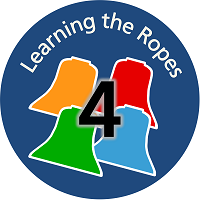Simulator Toolbox
3. Teaching with a simulator
3.4. Novice Change Ringer - LtR Level 4
Benefits of using a simulator
 As ringers progress through the higher Learning the Ropes Levels, simulator sessions should still be used to consolidate foundation skills – bell handling, ropesight and listening. Remember:
As ringers progress through the higher Learning the Ropes Levels, simulator sessions should still be used to consolidate foundation skills – bell handling, ropesight and listening. Remember:
- Whilst learners can still practise supervised at separate simulator sesssions, they should be safe enough to practise on their own on a spare bell or dumbbell at the normal practice.
- Exercises or unusual combinations can be rung without worrying what it might sound like outside.
- New ringers should be encourage to analyse their ringing, looking for patterns, in order to improve their performance.
- Simulator sessions add an element of fun and variety to any practice.
Analysing ringing to improve performance
Two ringers came for daytime sessions – they were both poor strikers. They hunted and covered and we analysed their ringing, playing it back so that they could hear what being late or early looked like on the speed chart, and sounded like, at the same time. We looked at patterns. One of them was always too soon at backstroke; the other always rushed the handstroke leads. Talking about what caused it, how to change, clearing up misconceptions (e.g. about speeding up to lead when you are already at hunting down speed) and practically, by ringing a single bell, balancing it at each backstroke, getting the tail end in the right place etc, all helped. They have both since been in winning or highly-placed bands, in guild striking competitions.
Ringing methods inside
Moving on to ringing a method inside a number of new challenges present themselves:
Where to start- How to learn circles of work
- Longer more complex blue lines
- Passing the treble
- Calls
Practising at home on a laptop or in the tower with a silenced bell ensures open practice is used most effectively.
- The screen diagrams help explain various elements of theory – blue line, order of work, starts, passing the treble, the grid and seeing what happens at calls. What you see on the screen and the experience you gain using the simulator software
is a great way to understand what methods are all about. - Practise ringing a plain course by pressing a key on the keyboard or on a bell or dumbbell, ringing all inside bells.
- Once the plain course has been mastered a new ringer can then practise ringing touches.
- The student can get used to saying go and stop and experiment with calls before trying it for real. They can also print out the touches that they have called to see the effect of the calls.